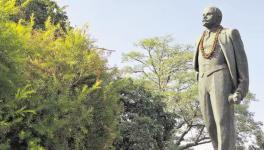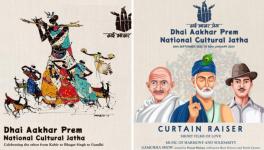Remembering Socialist Revolutionary Bhagat Singh
Returning to my hometown in Bengal after a gap of three years, I noticed that the famous Bhagat Singh Chowk now had a full-sized idol of the revolutionary icon. A yellow turban had replaced the hat on his small bust. Most disturbing was the Khanda Sahib, a Sikh religious symbol, in the background. Even his name was engraved with the prefix ‘Sardar’. Very clearly, it was a conscious attempt to whitewash Bhagat Singh as an atheist and socialist revolutionary who wanted to end the exploitation of man by man.
There is no better occasion to remember the real Bhagat Singh than on his 114th birth anniversary. Bhagat Singh was born to a Jatt-Sikh peasant family in the village of Banga in the Lyallpur district (now Faisalabad, Pakistan Punjab). He went to the DAV School, Lahore, and at fifteen, joined the National College in Lahore.
The Jallianwala Bagh massacre had a significant impact on the young Bhagat Singh. The tragedy exposed the sinister side of British imperialism. The killing confirmed that the moderate methods of the Congress, which included prayers, petitions and pleas, had failed. A wave of disillusionment ran within the Punjab, which contributed the most men to the British war effort during the First World War. It led to a rapid radicalisation of the youth in the state. Bhagat Singh visited the Jallianwala Bagh in April 1919 and brought back a fistful of the blood-soaked sand.
The Non-Cooperation Movement launched by the Congress party absorbed much of the energy of the Indian youth, but not for long. After Gandhi unceremoniously suspended the movement in 1922, the youth had no option but to take the radical route. Bhagat Singh, who took an interest in the railwaymen’s strike when he was fourteen and welcomed protesting Akali workers to his village after Mahant Narain Das, in collaboration with the British authorities, killed at least 140 Sikhs, was drawn to such tendencies.
Bhagat Singh reached Kanpur in 1923 and wrote a letter to his father, who was trying to restrict his revolutionary energies by getting him married, saying ‘his life [was] dedicated to the nation and so [he] could not think of marrying’. In Kanpur, he met Hindustan Republican Association (HRA) members such as BK Sinha, Shiv Verma, Jai Dev Kapoor and Ajoy Ghosh.
Bhagat Singh came to socialism and Marxism in search of an ideology for two reasons. The earlier revolutionary tendencies in Bengal and Punjab carried a strong religious element. It naturally closed the method and the movement to Muslims, Sikhs and secular-minded revolutionaries. Second, the Bolshevik Revolution had posed the biggest challenge to capitalist imperialism. Its leaders Vladimir Lenin and Leon Trotsky, were the first international politicians to call for self-determination for the colonies. During the Ninth All-Russian Conference of the Communist Party in 1920, he pointed out that “revolutions in Asian countries would display an even greater distinction than the Russian revolution”. In October 1917, Trotsky proposed India’s right to self-determination along with Ireland and Egypt.
Further, Bhagat Singh embellished himself at the Dwarkadas Library, where he voraciously read Marxist literature. The direct outcome was the re-naming of the HRA on Bhagat Singh’s behest. During a meeting of the HRA in Delhi’s Firoz Shah Kotla on 8-9 September 1928, he proposed adding ‘socialist’ to the organisation name. Fellow revolutionaries like Sukhdev, BK Sinha, Shiv Verma and Jai Dev Kapoor supported him, and HRA became the Hindustan Socialist Republican Association (HSRA).
“This change of name was not ornamental,” says the famous Bhagat Singh historian Prof. Chaman Lal. He argues that unlike Indira Gandhi, who added ‘socialist’ to the Preamble of the Constitution, for Bhagat Singh and his comrades, “it was a well thought out qualitative change of perception about the goal of the Indian revolution.” He notes that before the HRA became HSRA, Bhagat Singh trained himself in mass organisational work through the Naujawan Bharat Sabha, created on the pattern of Young Italy and inspired by Mazzini and Garibaldi. During this period, the ex-Ghadarite revolutionaries disillusioned by anarchism and trained in communism praxis at the Eastern University of Toilers in Moscow returned and set up the journal, Kirti. Bhagat Singh and worked as part of the editorial staff of Kirti.
He met Muzaffar Ahmad, a founding member of the communist movement in India when the latter visited Lahore after release from jail in the 1924 Kanpur Conspiracy Case. Fellow revolutionary Batukeshwar Dutt, who later joined Bhagat Singh in throwing a bomb in the Central Assembly, had worked in the Workers’ and Peasant’s Party, the communist front after the non-cooperation movement. The revolutionary program of the HSRA had the closest affinity with the communists.
The youth staged massive demonstrations when PC Joshi, who at 28 became the first and youngest general secretary of the Communist Party of India, was arrested at Allahabad University. Ghosh writes in his essay Bhagat Singh and his Comrades, “We felt sympathetic to the communists and at one time even contemplated some sort of a working alliance with them to organise masses and conduct the mass movement. We of the Hindustan Socialist Republican Association (HSRA) planned to work as its armed section. But when we learned that the communists considered armed action by individuals to be harmful for the movement, we dropped the idea.”
After the hanging of Bhagat Singh, Sukhdev and Rajguru, and the death of Chandrashekhar Azad, most of the revolutionary youth joined the communist movement. Since the Indian national movement assumed a mass character from the mid-thirties to independence, a political party with a constructive program was the best
qualitative substitute of self-sacrifice.
Bhagat Singh was hanged when he was just 23 years old. Yet his thoughts had matured to an unprecedented degree. Far from seeking ideological succour from the scriptures, he was an unrelenting critique of religion and its trappings. In a short essay titled Religion and Our Freedom Struggle in 1928, he made solid suggestions for unity among India’s people. He wrote, “We are aware that chanting some higher order ayat and mantras can be used to draw different interpretations, but the question is why should we not get rid of this entire problem?” In 1930, he wrote the iconoclastic essay, Why I am an Atheist, theoretically expanding his critique of religion. Unfortunately, no government in India since independence has considered including it in the educational curriculum. A simple reading of the essay can confirm the readers about its potential to cultivate scientific temper among the youth of India. It would expose the cunning of those who want the world to see a turbaned Bhagat Singh.
He also made a penetrating critique of the caste system and the half-hearted Hindu reformers to alleviate this social evil. He wrote, “Even in the twentieth century, if a low caste boy garlands people like the Pandits or the Maulvi, they have a bath with their clothes on.” He argued against his family’s more egalitarian Arya Samaji belief system when he wrote, “Swami Dayanand abolished untouchability but he could not go beyond the four varnas. Discrimination still remained”.
In a pamphlet, The Issue of Untouchability, he reiterated the strategy of Naujawan Bharat Sabha not to use the term untouchables. He argued, “We should ask for forgiveness of those who have been called untouchables and consider them to be equal human beings like us without being given the amrit, without reciting the kalma or being purified, and count them among ourselves.”
India needs to recall this prodigious revolutionary more than ever today. In 2019, when Members of Parliament took their oaths of office, Lok Sabha roared with slogans of Jai Shri Ram, Jai Maa Kali and Allah-hu-Akbar. We need to remember that the Naujawan Bharat Sabha banned all religious slogans and strictly adopted the revolutionary and secular slogans Inquilab Zindabad and Jai Hind for its members. Bhagat Singh was an intellectual giant whose revolutionary legacy India and all of South Asia must nurture.
The author is a research scholar with the Department of World History, University of Cambridge. The views are personal.
Get the latest reports & analysis with people's perspective on Protests, movements & deep analytical videos, discussions of the current affairs in your Telegram app. Subscribe to NewsClick's Telegram channel & get Real-Time updates on stories, as they get published on our website.
























